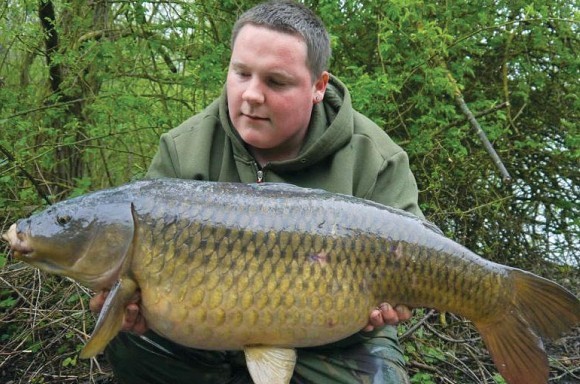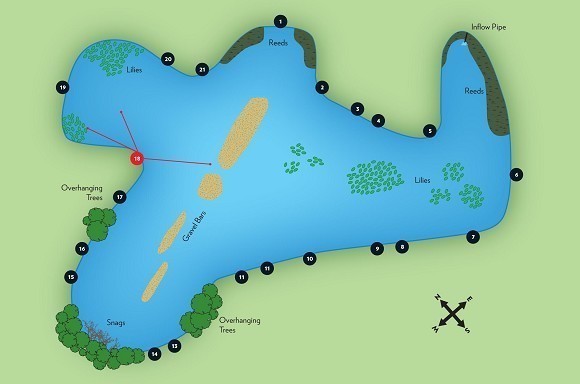
Location Corner: Brad Greening
Ever turned up to a lake and been unsure of what to head for? Here we describe a situation to a successful angler and get them to detail what they'd do.
Finding the fish first and being on them is great advice for any session, but how do you put that into practice at busy day ticket venues? Well, one carper that’s been doing massively well on this type of venue is Brad Greening. So let's see what approach he decides upon with our hypothetical venue this month.
To get things started we’ve told Brad that he is permitted three rods on this fairly busy water. The fishing conditions are cloudy with sunny spells and there is a gusty SE wind of around 15 - 20mph, the air-pressure is not too high at 1006. Already there there are a number swims taken, with Pegs 1, 2, 6, 8, 10, 12, 14, 16 and 17, occupied by anglers plotted-up around this lake roughly six-acres in area.
Okay, that’s the scenario, now lets see what swim Brad goes for and where he’d cast his rods…

“Day ticket fisheries are often very busy and from experience, on heavily pressured waters like this you will often find the fish where there are no lines in the water. Or as soon as there are too many lines in one area they will soon move to a section of the lake with the least angling or ideally is pressure free.
Upon seeing this lake map, the first thing I did was look at which swims are taken. There are lines pretty much around the whole of the lake, except for swims 18, 19, 20, and 21, which cover the north-northwest area of the lake.
Then looking at the wind speed and direction, the wind is a gusty south-easterly between 15 and 20mph, blowing into the north-west section of the lake.
In the summer time, a south-east wind is generally a nice warm wind. So with the wind blowing into a bay free of lines it was an easy indication of which part of the lake to fish.
All I had to do then was chose either swim 18, 19, 20 or 21. After analysing the swims, Peg 18 looks as if it covers the most water and gives the most options. The swim gives access to fish down into the bay to the left, and on the right hand side there is a series of bars, which offer more features to fish.
I have chosen to fish my right-hand rod at the bottom of the gravel slope, in between two gravel bars. The reason being a little deeper channel in between the two bars just absolutely screams carp patrol route and great interception point if the fish were to move from the open water into the bay.
Also it would give me better line lay rather than fishing on top of the bar. Bait- and rig-wise, I would use my favourite boilie rig, which is a Stiff Hinge Rig with the boom stiffness and material dependent on the lakebed. If the bottom were hard and gravelly I would use a stiff fluorocarbon boom; whereas if it is silty or a soft bottom I would use a soft coated braid boom.
The middle rod is fished into the entrance of the bay and on this rod I have chosen to use a Zig Rig and alter the depth throughout the session. If the fish are moving in and out of the bay, then this rig is perfect for intercepting the fish at different depths of the water column, as they travel in and out.
Finally, the left-hand rod is fished down the left margin on the edge of some lily pads in the corner of the bay. Lilies are awesome magnets for attracting carp and on pressured lakes they offer coverage and appeal to carp as a ‘safe’ area.
When fishing lilies, I like to fish as tight as possible to them without actually fishing inside them. This is a lot safer for the fish and I feel it also gives a much better presentation and line lay.
Rig-wise I would use exactly the same as what I’m using on my right hand rod as I have so much confidence in the Stiff Hinge Rig, which is my preferred boilie approach. The only difference this time is that I would ensure I’m fishing a tight line with the lead set to eject on the take for optimum carp safety.”




